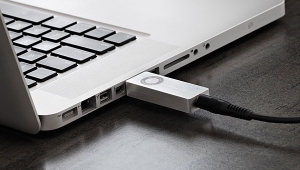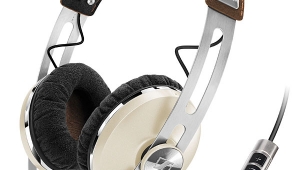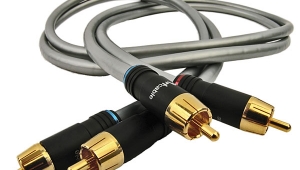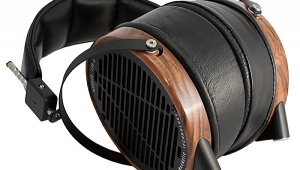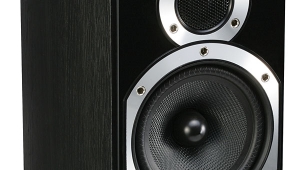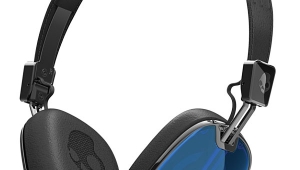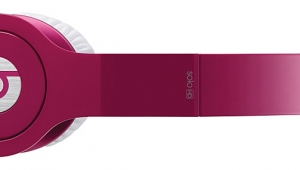| Columns Retired Columns & Blogs |
The Entry Level #41 Page 2
In spite of its assertive model name, the Statement is actually the most modest preamp in Lehmannaudio's Black Cube line, which now includes the standard Black Cube ($629), the Black Cube SE ($929), and the Black Cube SE II ($1149). All but the last—which, oddly, is neither black nor a cube—are physically identical and have gone nearly unchanged since the original Black Cube was introduced in 1995. They measure about 4" W by 1.75" H by 4.25" D and weigh just a few ounces. As you ascend the line, the quality of internal parts improves and the overall circuit design grows in sophistication. At one end of the Statement are a ground plug and a pair of gold-plated RCA inputs; the opposite end provides an input for the external AC power supply (included) and a pair of gold-plated RCA outputs. The audio circuitry is housed in a simple, nonmagnetic aluminum case whose top panel is not etched, engraved, or otherwise adorned, but instead carries a sticker with the company logo and model name. But it's a nice sticker, and for $449 I don't mind it at all—in fact, I think it's kind of cool, in a no-nonsense sort of way. But I do wish the sticker had been more carefully centered on my sample's top panel. I'm picky like that. Everything under the lid, which is held in place by four small hex screws, is tidy and clean.
The Statement is surprisingly versatile: Four options of gain (31, 41, 51, and 61dB) and three of input impedance (1k, 47k, and 100 ohms) can be selected with two sets of four DIP switches each on the bottom plate. In addition, custom load impedances (for cartridges that require special loading) can be achieved by inserting resistors into two open slots on the Statement's circuit board. If that sounds intimidating, don't worry about it. "Install these resistors only if you know what you are doing," the Statement's manual advises. "Otherwise, please consult your dealer." If your cartridge requires a custom load, you're probably already familiar with this sort of thing, and the Statement's manual offers plenty of support for the task. Otherwise, call that dealer. From the factory, the Statement is set to accommodate MM cartridges, such as the Ortofon 2M Red. I didn't have to touch a single DIP. The rest of my system comprised KEF's LS50 loudspeakers, AudioQuest's Rocket 33 speaker cables and Big Sur interconnects, and Kimber Kable's TAK-Cu phono cable.

"Love Is to Die," currently my favorite track on Warpaint's new, self-titled album (LP, Rough Trade RTRADLP680), opens with drummer Stella Mozgawa tapping out a tight rhythm of rapid rim shots and closed hi-hat—a theme that returns throughout the song—while Emily Kokal's synth patterns gradually grow louder and move toward the listener. Through the Arcam A19's built-in phono stage I heard a very solid and well-focused center image, the rim shots and cymbal work presented with natural tone, great speed, and clarity. The Statement preserved that strong center image but threw a far wider, deeper, taller soundstage, and provided more clarity and presence overall. I enjoyed more snap and bite in those rim shots, more sparkle in the electric guitars, more punch in the bass guitar and kick drum, greater separation between the lead and backing vocals.
Compared to my long-term reference phono preamp, an NAD PP 3 (discontinued; $199 when last available), the Black Cube Statement brought the music forward and produced greater dynamic contrasts, adding excitement and drama to my listening. The NAD sounds laid-back and reserved, but nonetheless produces a smooth, seductive sound, with an especially fine sense of rhythm and pace. Listening to the Lehmannaudio was like opening a window and sticking my head out to feel the cool, fresh air. Listening to the NAD is like enjoying that same view from a distance, in bed, under a cozy blanket. "Enjoy the day!" says the Lehmannaudio. "Why get up?" asks the NAD. It's hard to argue with either.
But, ultimately, the Statement's generous soundstage, awesome clarity, beautiful detail, and fast attack transients proved impossible to deny. A spacious, dynamic recording like James Blake's Overgrown (LP, Republic B0018305-01) seems made to be heard through the Lehmannaudio. Listening to it was an absolute thrill and joy: The sound was gripping, dramatic, and emotionally compelling, with frighteningly deep silences, well-controlled bass, clean highs, and superb presence. I felt I was right in the middle of the music, and I loved it. The Lehmannaudio Black Cube Statement is an awesome little phono preamplifier—versatile, powerful, and true to the music. At $449, it strikes me as a bargain. Get your hands on one.
Bozak Madisson CLK-PH2 moving-magnet phono preamplifier
But if you're just getting interested in analog playback and are anxious to start spinning LPs, the Lehmannaudio Black Cube Statement might seem prohibitively expensive. After all, some outstanding turntables—Pro-Ject's Elemental ($199), Essential ($299), and Debut ($399) come to mind—are significantly more affordable.
What's a guy or gal to do? I visited The Everything Store—the devil's own website, Amazon.com—where I searched for phono preamplifiers and sorted the results by price, from low to high. The least costly phono preamp available from Amazon that day was the Taiwanese-made Bozak Madisson CLK-PH2 ($19.95, plus $7.49 shipping). I bought it. Of course, afterward, distraught with guilt, I marched straight to our local bookstore, Word, and paid full price for five new hardcovers: Why I Read, by Wendy Lesser; Smarter Than You Think, by Clive Thompson; Writing on the Wall, by Tom Standage; Absolute Value, by Itamar Simonson and Emanuel Rosen; and The Sound Book, by Trevor Cox. Each cost more than the Bozak Madisson. I guess we have Jeff Bezos to thank for this.

The Bozak Madisson is completely fine. It works only with moving-magnet cartridges, provides no loading options, and has no power indicator light—but, like the far more expensive Lehmannaudio Black Cube Statement, it's small, has a ground pin, puts pairs of ins and outs on opposite ends, and has a nice sticker on its top panel.
Compared to the Lehmannaudio or the NAD, the Bozak Madisson sounded smaller, darker, and more distant, with softer lows, edgier highs, and less accomplished senses of touch and momentum. But it was surprisingly quiet and, most important, preserved the music's essence. I enjoyed everything I played through it—pop, rock, classical, jazz, rap, noise. For those in a serious pinch or on a really tight budget, the Bozak Madisson CLK-PH2 will do the trick. Totally recommended. But don't forget to support small businesses . . .
Mooo Mat record mat
. . . and the cattle industry? Distributed by Music Hall, the Mooo Mat ($75) is a turntable platter mat with a bottom layer of cork and a top layer "made of real cowhide from real dead cows (vegans and PETA need not buy)." The FAQs page at Mooomats.com explains that the dissimilar materials work to reduce vibrations, and the cowhide lifts and decouples the record from the platter. In addition, because cowhide has "natural antistatic properties"—an evolutionary development due to cattle's risk of being struck by lightning while grazing on the prairie?—the Mooo Mat is claimed to reduce unwanted static on the surface of an LP. Hmm. I don't mooo about all that, but I do know that the Mooo Mat looks really cool, in a mid-century-modern kinda way. It's very hip. Each Mooo Mat has a unique hide pattern. The cowhides are imported from South America, where they undergo a tanning process that "eliminates the possibility of shedding and produces no odor."
I tried a very pretty, brown-and-white (Ms. Little calls it "cognac and cream") Mooo Mat on the VPI Traveler, and though it was slightly thicker than the Traveler's stock mat, it didn't necessitate an adjustment of the Traveler tonearm's vertical tracking angle (VTA). The music sounded great—clear, bold, and beautiful. The little breath that singer Shara Worden takes before the first words of "You Will Return," from David Lang's heartrending Death Speaks (LP, Cantaloupe Music CA21092LP), was more obvious and lovelier than it had been before, and violinist Owen Pallett and guitarist Bryce Dessner seemed to pluck and strum their instruments' strings with more force and feeling.
However, I did find that the Mooo Mat left little brown (I mean, cognac) hairs on my LPs. These were easily removed with my Hunt E.D.A. Mark 6 record-cleaning brush, and the shedding lessened over time, but really—it kinda sucks when your record mat gets your records dirty. Moreover, I don't think the Mooo Mat did much to eliminate static. For that, I still needed to use my Milty Zerostat antistatic gun. To be fair, it was mid-February when I evaluated the Mooo Mat, and the air in our apartment was exceedingly dry; static had been especially troublesome, with or without the Mooo.
If you choose to steer (mooo!) clear of the Mooo Mat simply because it might shed on your LPs, I wouldn't blame you. Yeah. Don't have a cow, man. But, if you buy the Mooo Mat simply because it's cool, I still wouldn't blame you. It's a fun, attractive, great-sounding tweak. If that suits you, go for it.
Audio Intelligent Vinyl Solutions Down With Dirty Enzyme Record Cleaning Concentrate
Here's another benefit of listening to LPs: When people know you like them, they begin giving them to you. If I accepted all the LPs I'm offered, Ms. Little would be forced to kick me out of the apartment, or I'd have to rent a storage space entirely dedicated to vinyl. Perhaps this is a bad business model, but even record stores have begun giving away LPs. At Iris Records, in Jersey City, for instance, you can take as many as you want from a special selection near their cash register. LPs are like kittens: They're crazy cute, there are tons of them out there, and they need good homes.
They can also be extremely dirty. A few months back, when Ms. Little and the girls returned from Argentina, Natalie brought me home the gift of an LP: Fiesta en el Pueblo, by Cuarteta del Ayer (Jocker 13001)—a collection of joyous polkas, foxtrots, and Argentinean rancheras. Although the inherent beauty of both the cover art and the music are impossible to diminish, someone damn well tried. I've rarely seen such a worn-out, abused LP. The outer sleeve looks and feels as if it had been tossed in the ocean and, weeks later, washed ashore, there to be battered by sand and burned by sun; it's basically tissue paper. There was no accompanying inner sleeve, so you can imagine the condition of the LP itself: scratched, and covered in dust, debris, and fingerprints.
But I enjoy cleaning LPs. The satisfaction I get from the task may be something similar to what Ginger Pete feels when he rebuilds a motorcycle engine, or what Kanibal Kristen feels when reupholstering an antique chair: We're bringing new life to some old, neglected object, preserving it not just for ourselves but for a future generation. Most recently, when washing LPs on my classic VPI HW-16.5 record-cleaning machine, I've used the Audio Intelligent Vinyl Solutions line of cleaning fluids. I have them all: Enzymatic Formula, Super Cleaner Formula, Premium Archivist Formula, Ultra-Pure Water, Premium One-Step Formula No.6, Premium Record Cleaner Formula No.15—and, now, Down With Dirty Enzyme Record Cleaning Concentrate ($80). Each serves a different purpose, and can be used singly or in combination with the others.
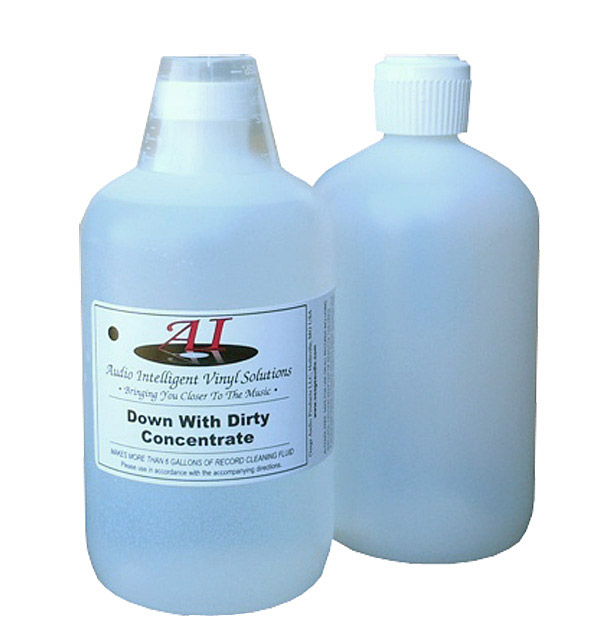
I imagine that, to most people, $80 would seem like an awful lot of money for a 16oz bottle of record-cleaning fluid—it seemed that way to me—but Down With Dirty is a concentrated formula that makes up to 24 quarts (six gallons) of fluid. That's a lot of record-cleaning fluid. The kit includes one 16oz bottle of concentrate, a measuring cap, and a second, empty 16oz bottle. You fill the empty bottle with distilled water—a gallon of which I purchased (along with a box of Russell Stover chocolates and a six-pack of New Jersey Beer Co. Hudson Pale Ale) for $1.29 at Palace Drugs and Liquors, on Newark Avenue—add 10ml of the concentrate, swish it around, and you're done. I detected no odor whatsoever, but swishing the mix did create some bubbles.
For tougher cleaning jobs, AIVS says you can use up to 20ml of concentrate per 16oz bottle of distilled water—but LPs cleaned with the more heavily concentrated solution should then be rinsed with distilled water. The standard Down With Dirty solution can be used without a subsequent rinse. If you use the concentrate only at its regular strength, you'll have enough to make 48 16oz bottles of record-cleaning fluid. That works out to $1.60/bottle, which is very inexpensive. It would be nice, though, if the kit included two empty bottles: one for a regular-strength solution, the other for a double-strength solution.
I played Fiesta en el Pueblo once prior to cleaning it, then again after cleaning it with the standard concentration of Down With Dirty. Before cleaning, the record was not only very physically dirty but, as expected, very noisy, with countless pops and ticks and one skip. After cleaning, it looked a million times better—all but the most deeply ingrained prints were removed—and the sound had also improved. There were still some pops and ticks, but they were more subdued, and now seemed separate from the music rather than an integral part of it. The sound and music were now about equally lively and compelling—and the record no longer skipped. I suspect that this LP, dirty as it was, would have benefited from additional cleaning, or a heavier concentration of the active ingredient—but for most normal jobs, Down With Dirty Enzyme Record Cleaning Concentrate at normal strength may be all you'll ever need. If only it could shovel snow . . .
- Log in or register to post comments


